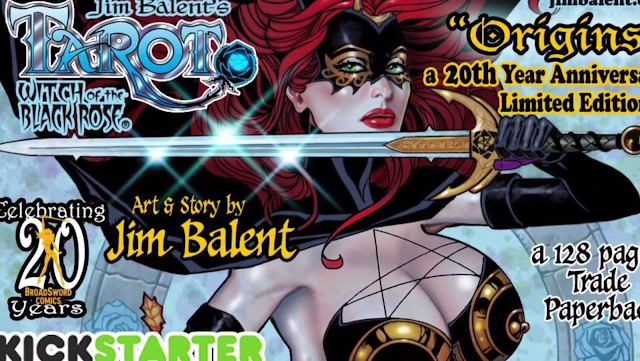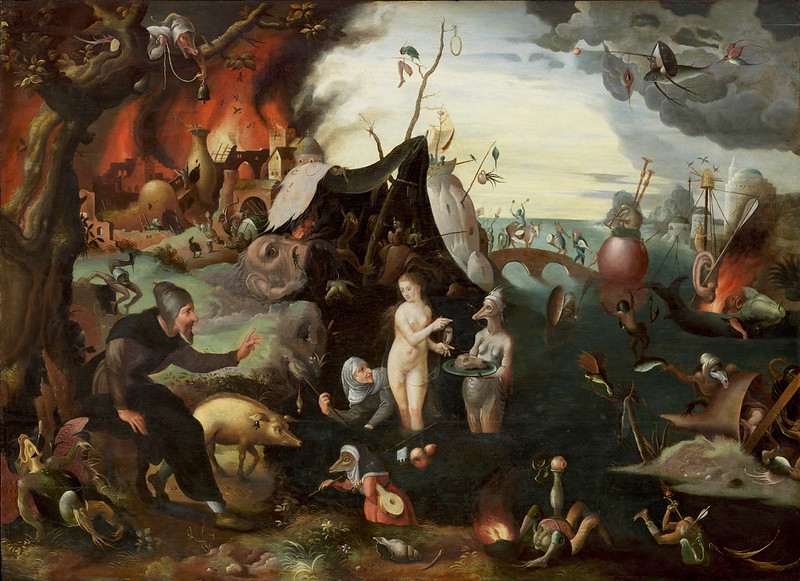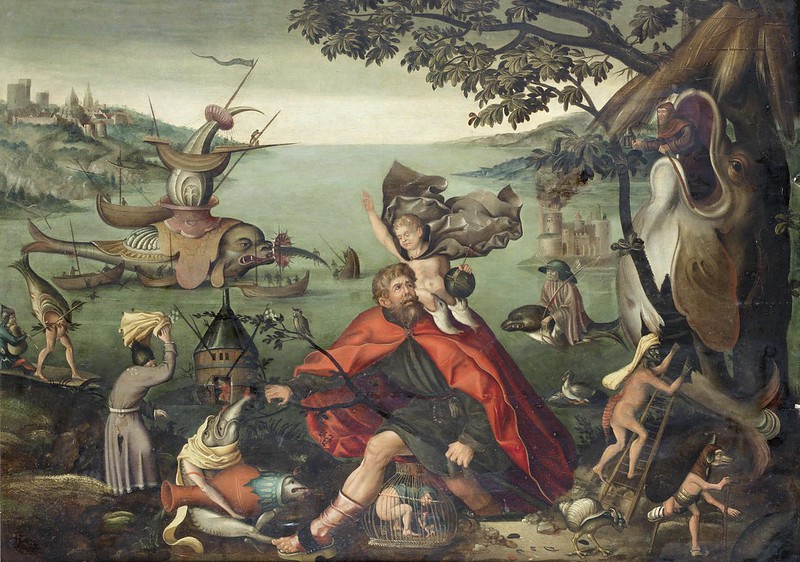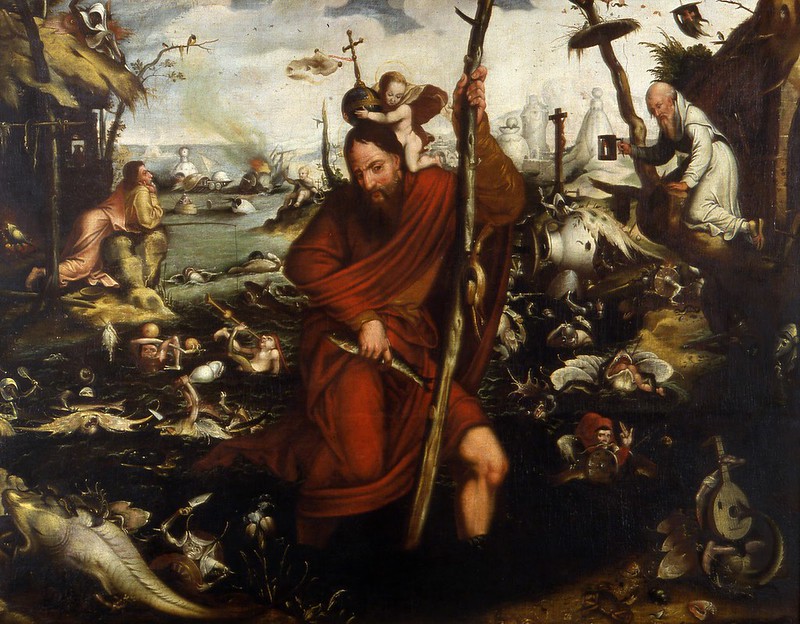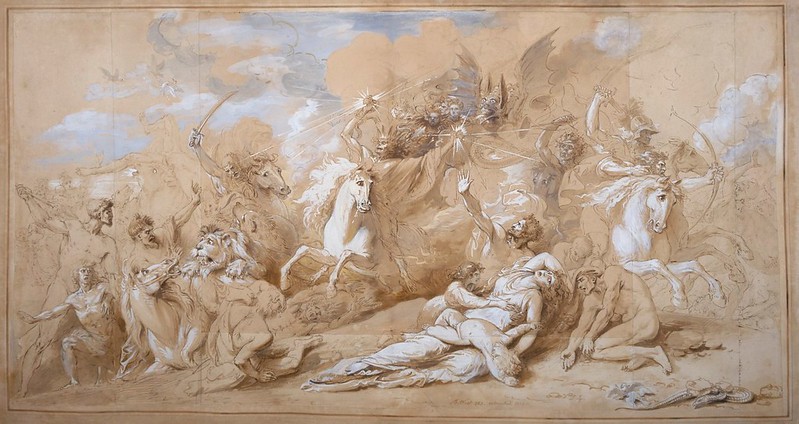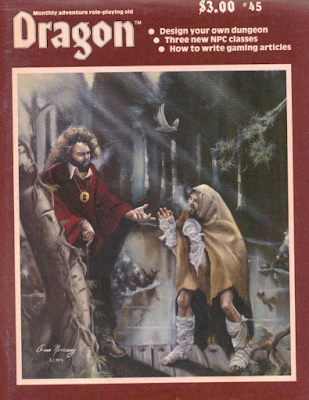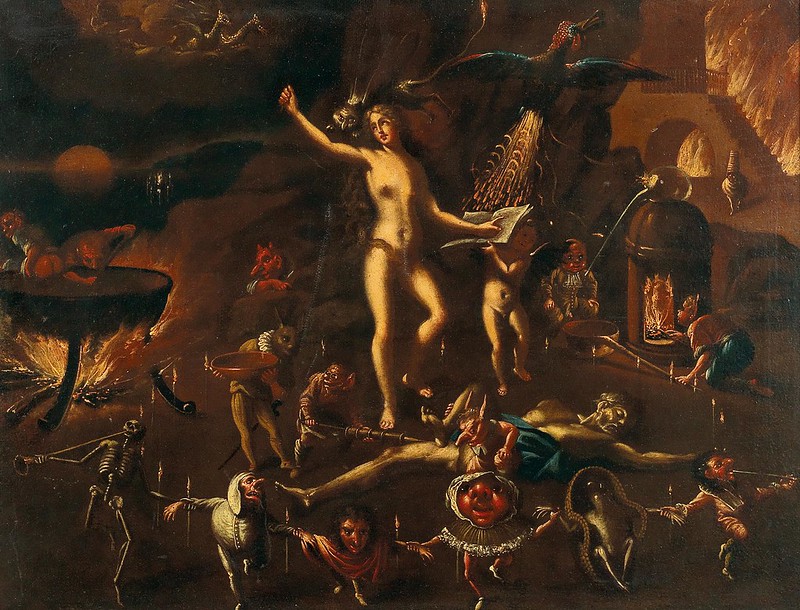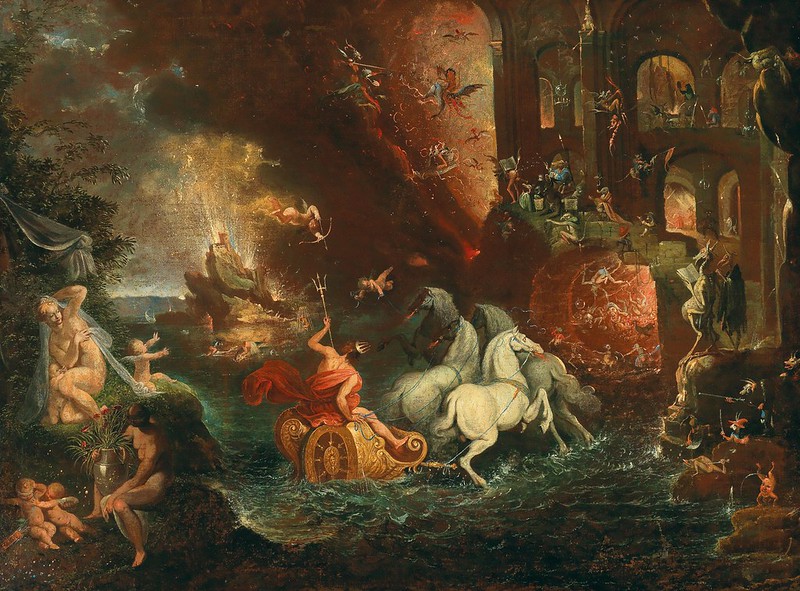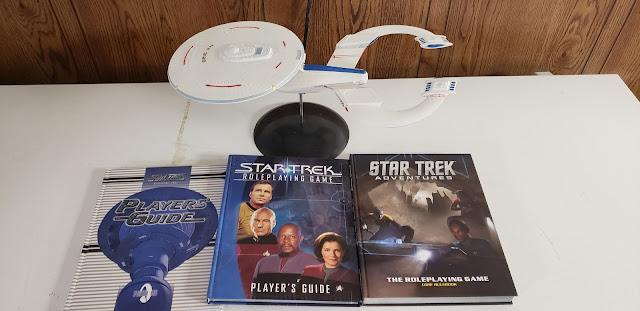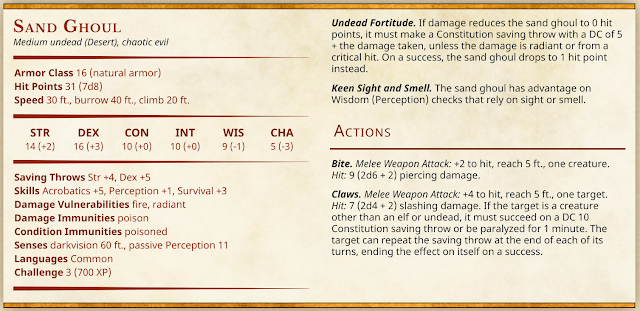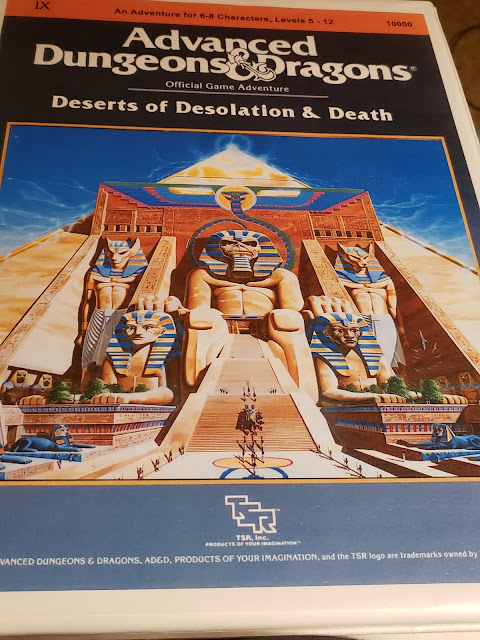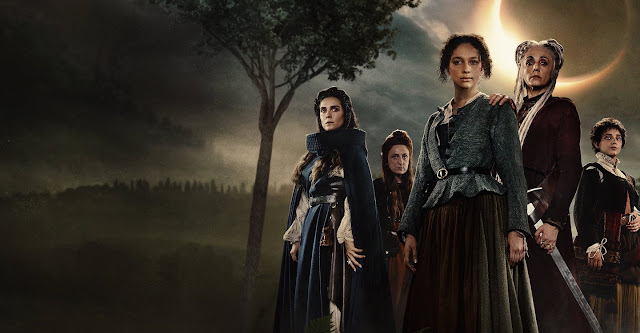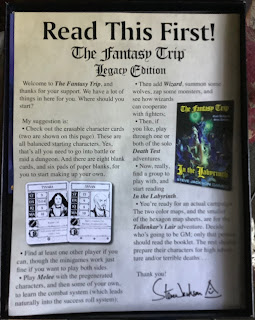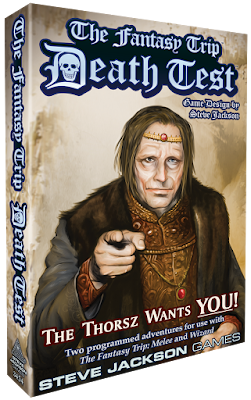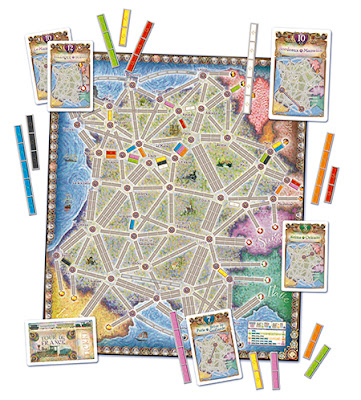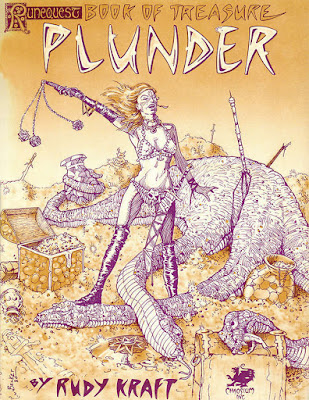
By 1980,
RuneQuest had begun to mark itself as a roleplaying game and setting in the form of Glorantha, which was very different in comparison to other fantasy roleplaying games. It was skill-focused and emphasised every player characters’ faith and belief system and world view in the context of the world of Glorantha, especially in the form of the superlative
Cults of Prax. Then came along
Plunder, a supplement detailing some six-hundred-and-forty pre-generated treasure hoards and forty-three magical treasures of Glorantha.
Plunder does not add as much to the world of Glorantha, but it does support it, both in terms of the mechanics and the background.
The first half of
Plunder consists of ten tables, each an eight-by-eight grid, thus providing sixty-four results in each table. In each space is the listing for a treasure hoard that the player characters might be found in their intrepid adventures in Glorantha. This might be nothing; 38 Clacks; 406 Clacks, 364 Lunars, 30 Wheels, and a single gem or piece of jewellery; or 1068 Clacks, 1383 Lunars, 332 Wheels, four gems or pieces of jewellery, and a special item. When the Game Master needs to determine the contents of a hoard, he turns to a table and rolls two eight-sided dice to get a result. Two further tables enable the Game Master to determine what the gems and jewellery are if there are any and what the special items are if there are any. So the gems and jewellery might be an excellent gemstone worth 900 Lunars or costume jewellery worth 45 Lunars, and special items might be a scroll written in Stormspeech which grants a +5% bonus to the Dagger skill if studied, an eleven-point Power storage crystal, or a wand with the Glamour matrix on it.
Mechanically, this all ties into the use of Treasure Factors from the second edition of
RuneQuest, recently republished as
RuneQuest Classic. Treasure Factors are are means of determining how much loot a monster or an NPC might. The Treasure Factor for any one creature derived from its Hit Points, combat skills, how many extra dice are rolled when it inflicts damage, armour, combat spells, special powers, any poison used, and any extra attacks. If there is more than one monster or NPC, their individual Treasure Factors are added together, and the final value broken down into groups of a hundred. When it comes to using
Plunder, the Treasure Factor is used to determine which table the Game Master will roll on when it comes to generating the hoard for a monster or an NPC. So for a single Trollkin with a Treasure factor of six, the Game Master would roll on the very first table in
Plunder, but add a whole lot more Trollkin and mix in a Dark Troll or two, and the Treasure Factor rises rapidly so that the Game Master will be rolling on a table later in the book. In general, if the Game Master knows the Treasure Factor, she can generate a treasure hoard with just a handful of rolls.
The second half is dedicated to just some of the magical devices to be found on Glorantha. These range from the marvellously mundane, such as the
Golden Torches which never go out, even underwater or in great darkness or
Soup Bones which can always be boiled to provide soup, to amazingly magical, like
Tora’s Hammer, a stone Warhammer wielded by a hero during the Dawn Ages who slaughtered untold numbers of Mostali with it and which returns to the hand if thrown, and
Glass Butterflies, tireless magical messengers which will deliver a spoken phrase anywhere in the universe! Many are very particular in terms of who can use them, such as
Morokanth Thumbs, black lumps of thumb-like flesh which when Power is sacrificed, the thumbs can attach to a Morokanth’s hands and enable him to be as dextrous as any human, whilst others are tied to a particular cult. For example, the
Lightning Bands once worn by the bodyguards of a high priest of Orlanth Thunderous, which when imbued with Power, enables the wearer to blast out a bolt of lightning via a spear. There are treasures from the Aldryami and the Mostali, Chalana Arroy, Chaos, Kyger Litor, Dragonewts (and from Dragonewts), Waha, Stormbull, and more. Some have more generic links such as Fire or Sky cults.
Every item follows the format. A description, followed by a listing of the cults associated with the item as well as those friendly, hostile, or enemy to it; a discussion of how common knowledge of the item is, ranging from common to one of a kind or owner only; its history and the procedure required to use it (and sometimes make it); and lastly powers and value. The latter should one come up for sale. For example,
Bajora’s Shield is a large iron shield with a glowing Death rune on it. It is associated in friendly fashion with Humakt and knowledge of it is automatically known to Humakt’s cult, though it is a cult secret, it is famous and one of a kind. Its history is that it was originally carried by Bajora, a friend of Humakt who sacrificed his life to save Humakt from a thing of Chaos. All that was left of Bajora was his shield, which Humakt carried for the rest of Godtime in his honour. Humakt refused to use it though and so since time began, none of his followers can either. They do know of the shield’s powers, so anyone wielding it and wanting to use if to its fullest powers needs to be on good terms with Humakt’s cult.
The procedure to use it requires the wielder to be a Rune Lord of a cult not an enemy of Humakt. He must then sacrifice a point of Power. Once attuned it grants a +20% bonus to the wielder’s Shield skill, the same effect as the
Shield 4 spell when in melee,
Light spells on command with no expenditure of Power, and immunity to Sever Spirits when cast anyone other than a Humakti. The value 120,000 Lunars and selling it would offend any Humakti (although buying it to donate to the temple is fine).
One issue perhaps is that a few of the items are unlikely to come into play, for example, the
Aluminium Tridents of various sea cults, and of course there are some treasures which are unlikely to fall into the hands of the player characters—mostly Chaos related. Plenty of the others though will be desired by the player characters and some will certainly be subject of great hero quests. If there is an issue with the selection it is that there are few treasures related to the Air and Earth cults, but that is likely due to the contents of
Plunder, like
Cults of Prax before it, being set in Prax rather Sartar and its surrounds.
Physically,
Plunder is again a book of two halves. The first is tables—large, open, and easy to read tables, but tables nonetheless. The second is more open, with one or two entries per page. Some are illustrated, some not, but the artwork is decent, if a little ‘Swords & Sorcery’ in style in places. If any of the artwork is disappointing, it is the cover, which comes from the ‘chainmail bikini’ school of female depiction in fantasy. The skull panties are a notable feature.
At the time of its release, critics could not agree about
Plunder. In
Space Gamer Number 33 (November 1980), Forest Johnson said that, “About half this book is not very useful. It consists of a shorthand method for generating treasure. (This does nothing to lighten the real work – adding up all those cursed treasure factors.)”, but ended on a positive note, concluding that, “The lack of exotic magic items has heretofore been a weak point in RuneQuest. These items have authentic Gloranthan flavour, complete with history and cult affinities. The discreet use of these items will add spice to a campaign without reducing it to Monty Haul.” Conversely, writing in
The Dungeoneer’s Journal Issue: 25 (February/ March 1981), Clayton Miner said, “The variety of the items, and the detailed information included with the great treasures is sure to make this book very useful to Judges. Of more use to a Runequest Judge is the first section of Plunder, which presents easy to use tables for determining that value of a lesser treasure…” and that, “…[T]his book would make a welcome addition to a Judge’s stock of Runequest items. Plunder is definitely a useful piece of work and shows a great deal of imagination, and the only question I had with the book as a whole is, why so none of the items listed under Treasures of Glorantha have a negative side effect on the user.”
Other reviews were more balanced. Oliver Macdonald, reviewing
Plunder in
White Dwarf No. 25 (June/July 1981) awarded the supplement just five out of ten, adding that, “All points considered Plunder is an interesting but by no means essential RuneQuest play aid, certainly not worth buying if you have a limited budget.”
Plunder was reviewed by John Sapienza, Jr. in
Different Worlds Issue 12 (July 1981). Of the first half, he wrote that, “I think that a bit of reflection will let the GM realize just how dull it is putting treasure descriptions together, particularly those that get improvised during gaming. Once you realize this, the usefulness of this play aid makes it attractive.” He was more positive about the second half, saying that, “…[T]he treasures are, by and large, not out of balance, and most of them come complete with cult associations that provide effective limits on their use. Other limits are the tendency of certain races to take offense and kill the wearer, such as a suit of dragonewt skin armor. Use this at your own risk, in other words. Neat.” before concluding that, “Plunder is a useful idea, and well done. I recommend it to all RQ GMs.”
Plunder is a curio from a bygone age and another style of play. That style of play is one in which plunder is important. In
Dungeons & Dragons, it was treasure and it would directly count towards the number of Experience Points a character gained in addition to that gained from killing monsters. In
RuneQuest and Glorantha, the plunder paid first for any dues you owed to your cult and temple, second any monies owed to a cult, temple, or guild for prior training, and third for any skill or spell training undertaken with your cult, temple, or guild. Certainly in
RuneQuest II, all of this would cost a character thousands of Lunars. Not so in the latest iteration,
RuneQuest: Roleplaying in Glorantha, which presumes that a character’s training has already been paid for, though a character still owes his tithes to his cult and is encouraged to purchase further training. So there is less of an emphasis today on plunder when roleplaying and exploring Glorantha, as evidenced by advice given in the back of the core rulebook to cut the value of the treasure found when playing classic scenarios.
So, forty years ago in Glorantha, the need for treasure was greater. Player characters had debts. Thus, the Game Master had to seed his scenarios with plunder aplenty—well not too aplenty because the characters had to have a reason to be coming back for plunder and the peril which went with it—and that took time and effort. Forty years ago then, the tables in the first half of
Plunder were useful as they helped speed the process. Not so now when they feel redundant. Similarly, the second half of
Plunder with its listing of forty-three magical treasures was useful forty years ago because so few of them had been then detailed in the early days of
RuneQuest. So the forty three were useful, many of them tying into the cults described in
Cults of Prax and so helping to build the world of Glorantha just a little further.
Conversely, at this point in the history of
RuneQuest: Roleplaying in Glorantha, the current iteration of the roleplaying game has the same problem—few if any treasures of note have been detailed. There is background and detail to many of these forty-three items that the Game Master could bring them to her Glorantha today and they would still work. Doubtless, new supplements will appear detailing new treasures of Dragon Pass, but the conversion process is anything other than challenging. Until such a supplement is published,
Plunder is actually more than a curio.
There can be no doubt that
Plunder is no
Cults of Prax, for it is very much a curate’s egg. Its dual focus and character—divided equally between the mundane and magical—mean that one half is at best utilitarian, at worst bland, whilst the other by comparison rich in detail and flavour. Conversely, the Game Master is likely to have got more use out of the Treasure Tables than the individual items, even if they are mundane, but nevertheless, the actual treasures in
Plunder further showcase the more fantastical nature of Glorantha.
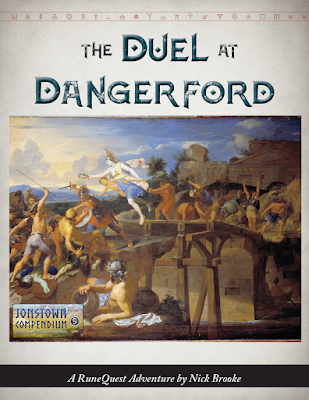 What is it?
What is it?







